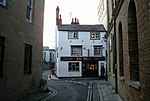The Chapel of Brasenose College, Oxford, dedicated to St Hugh and St Chad, was built during the seventeenth century, during Brasenose's second wave of building started under the Principalship of Samuel Radcliffe. It is believed to have replaced an earlier chapel where the Senior Common Room now is, and includes items of silverware from around the date of foundation. The chapel is in a mixture of architectural styles – Gothic, neoclassical, and baroque – and has not proven uncontroversial for this reason. The current chaplain is The Reverend David Sheen.Radcliffe having failed to start work during his lifetime, his will set aside money and instructions for the construction of the new chapel on the south side of the college. For this purpose materials were taken from college properties – particularly from St Mary's College, which provided the hammerbeam roof and other materials for the project. The chapel and library cost together £4,000 at a time when college income was £600 a year. Disputes over the will and other problems meant that work on the construction did not begin until 1656 (eight years after Radcliffe's death), and was managed by the college bursar. An "overseer" called John Jackson took control of the project, and is believed to be the chapel's primary designer. The chapel was consecrated in 1666, and must have been almost complete at that date.
Various alterations were made to the chapel after completion. Although repairs were undertaken in the meantime, the interior of the chapel was renovated (having fallen into a poor state) in 1819, and the exterior beginning in 1841. In 1892–3 a new organ was purchased and fitted, paid for by the then Principal Charles Buller Heberden; the current organ was installed in 1973, and rebuilt in 2002–3.








